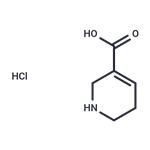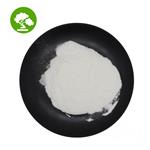Guvacine Hydrochloride is a GABA uptake inhibitor (hGABA T-1, rGABA T-2, hGABA T-3 and hBGT-1) (1,2,3). Gamma-Aminobutyric acid (GABA) is the major inhibitory neurotransmitter in the mammalian brain (4). Guvacine Hydrochloride may be useful for treating neuropsychiatric disorders.
Guvacine Hydrochloride is a GABA uptake inhibitor and it is used for the treatment of neurodegenerative diseases.
Guvacine hydrochloride is an alkaloid from the nut of Areca catechu, acts as an inhibitor of GABA transporter, and dispalys modest selectivity for cloned GABA transporters with IC50s of 14 μM (human GAT-1), 39 μM (rat GAT-1), 58 μM (rat GAT-2), 119 μM (human GAT-3), 378 μM (rat GAT-3), and 1870 μM (human BGT-3).
Guvacine hydrochloride is a potent inhibitor of GABA transporter, dispalys modest selectivity for cloned GABA transporters with IC50s of 14 μM (human GAT-1), 39 μM (rat GAT-1), 58 μM (rat GAT-2), 119 μM (human GAT-3), 378 μM (rat GAT-3), and 1870 μM (human BGT-3). Guvacine has low affinity at hBGT-1 (IC50 >1 mM). Guvacine hydrochloride is a potent inhibitor of GABA uptake, but does not inhibit sodium-independent GABA binding, and is weak or inactive as a GABA receptor agonist. Guvacine inhibits the uptake GABA and β-alanine with IC50s of 23 ± 2 μM, 66 ± 11 μM in the Cat spinal cord, and 8 ± 1 μM, 123 ± 28 μM in the rat cerebral cortex, respectively.


